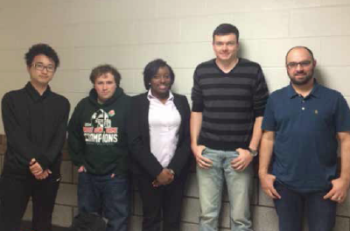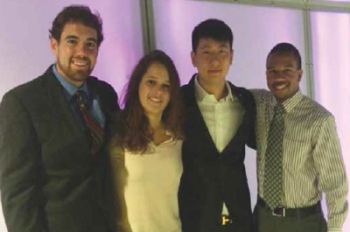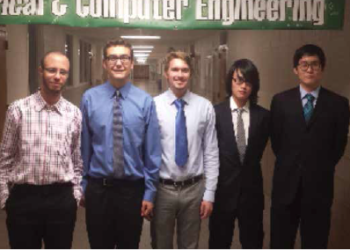Electrical Engineering
Projects
Electrical and Computer Engineering ECE 480 Senior Design is required of all electrical and computer engineering majors at MSU.
For information on becoming a project sponsor, please contact Gregg Motter.
The following are the project sponsors and projects for the fall of 2015:
Bekum America Corporation: Bottle Orientation Interface System (BOrIS)
The world around us is becoming increasingly intertwined with new technology systems. As technology progresses and becomes more complex, it is becoming increasingly more important for companies to present user interfaces that are unambiguous and easy to use.
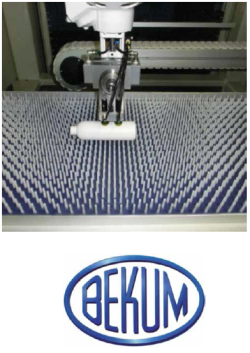 Bekum’s Bottle Orientation System has the capability of visually identifying the orientation of bottles and using a robotic arm to pick up and place these bottles accordingly on a conveyor belt to the next phase of production. Currently, the user must navigate complicated and time-consuming menus in order to configure new bottles for production. In order to improve efficiency and make their product more attractive, Bekum must provide a more user friendly interface with fewer steps.
Bekum’s Bottle Orientation System has the capability of visually identifying the orientation of bottles and using a robotic arm to pick up and place these bottles accordingly on a conveyor belt to the next phase of production. Currently, the user must navigate complicated and time-consuming menus in order to configure new bottles for production. In order to improve efficiency and make their product more attractive, Bekum must provide a more user friendly interface with fewer steps.
A solution to this problem is automating parts of the process for the user. Using a touch-screen, the machine operator would be presented with simple instructions and no longer have to navigate through menus that require no user input. With fewer steps to cycle through, the process becomes more efficient and less confusing for the machine operator and makes a more attractive product to sell in the bottling industry.
Whirlpool Corporation: Dispenser Cup Contents Detection
Whirlpool has been an Energy Star partner since 1998. Energy Star is a U.S. Environmental Protection Agency voluntary program which creates energy efficiency standards for companies to strive for in their consumer products.
 Whirlpool has developed high-efficiency washing machines which save water and energy. A method they use to improve efficiency is to determine if the detergent is a liquid or powder and if bleach or fabric softener is being used. The wash cycle process is optimized by using this information.
Whirlpool has developed high-efficiency washing machines which save water and energy. A method they use to improve efficiency is to determine if the detergent is a liquid or powder and if bleach or fabric softener is being used. The wash cycle process is optimized by using this information.
Currently, consumers manually input information regarding detergent type and whether bleach or fabric softener is being used. Whirlpool has identified that consumers usually do not take full advantage of the energy optimization offered by this method. This is due to either consumer negligence or incorrect input. Whirlpool wants to automate this process by detecting dispenser cup contents automatically.
To detect the contents of a cup, a light has to emit through the cup to be received by a sensor. If the content is a powder, no light will be sensed. If the content is a liquid, some light will pass through to the sensor. If the cup is empty, most of the light will be received by the sensor.
A micro-controller will be used to receive sensor information and output it to an application that emulates a washing machine. The application will display washing machine dispenser cup contents information that can be used to automate the wash cycle process.
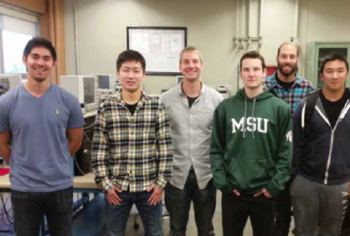
Team Members (Left to Right): Raymond Acker, Sung Gun Lee, Jacob Stanczuk, Trevor Eckler, Nolan Holmes, Doddy Jonathan
Great Lakes Controls and Engineering: Automated Lathe Tool Condition Monitoring
Great Lakes Controls and Engineering is a new engineering firm that was founded in 2014. They specialize in machine refurbishment, robotic integration, and troubleshooting and repair in industrial applications. Their latest project is the integration of a Fanuc robot with two super-finish grinders, which allows the grinders to be in nearly constant operation.
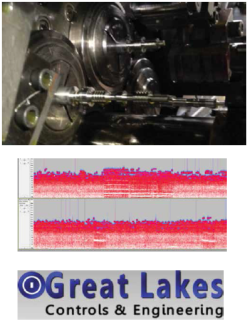 Our project focuses on tool wear detection on a specific machine serviced by Great Lakes Controls and Engineering. This machine is an automated lathe and is used to make transmission valves for automotive companies such as The Ford Motor Company.
Our project focuses on tool wear detection on a specific machine serviced by Great Lakes Controls and Engineering. This machine is an automated lathe and is used to make transmission valves for automotive companies such as The Ford Motor Company.
A solution to this problem is to develop a sensor capable of measuring the audible emissions from the tool as it performs its cutting operations. Once measured, the data can be analyzed by the on-board micro-controller to determine if the tool is acceptably sharp, or needs to be sharpened or replaced.
This system will provide the machine’s operator with information on the state of the current cutting tool. This information will be relayed through the existing programmable logic controller and displayed on the machine’s monitor.
Pictured on right (top to bottom): a transmission valve inside the automated lathe that has finished being machined, the unique frequency spectrum of a sharp tool, and the unique frequency spectrum of a dull tool.
Asante Solutions, Inc.: Blind User Accessible Insulin Pump Design
In the United States, approximately 40% of diagnosed diabetics have a form of diabetic retinopathy, which leads to decreased vision and blindness. This represents a significant portion of diabetics, resulting in an increasing need for an insulin pump that can communicate its data to someone who cannot readily read a screen. Currently, Asante Solutions, Inc. and Michigan State University’s Resource Center for Persons with Disabilities are working with our team to create possible solutions to this ongoing problem.
 Insulin pumps are small electronic devices that deliver insulin to the patient. The doses can be delivered in one of two ways: in a steady continuous dose or as a surge dose around mealtime. Pumps can be programmed by the user for either dose deliveries, depending on user preference. A patient will interact with his or her insulin pump at least four times a day, making communication between user and pump essential.
Insulin pumps are small electronic devices that deliver insulin to the patient. The doses can be delivered in one of two ways: in a steady continuous dose or as a surge dose around mealtime. Pumps can be programmed by the user for either dose deliveries, depending on user preference. A patient will interact with his or her insulin pump at least four times a day, making communication between user and pump essential.
Due to a growing demand for an insulin pump that can be controlled by a blind user, companies are seeking new ways to provide this service to their customers. Stephen Blosser of RCPD and our team have developed a case that will surround the Snap insulin pump. Using a text to speech integrated circuit, the additional case allows users to plug in their headphones and listen to their insulin pump. The circuitry within the case attains to be intuitive and noninvasive to the current circuitry of the Asante Snap insulin pump as it reports all necessary information from the viewing screen to its user.
ArcelorMittal: “Smart” Camera
ArcelorMittal needs a reliable and robust way to measure large coils of cold-rolled steel coming off their production line. The proposed solution is to use the Axis Communications P1355-E Camera to capture live high quality video of the steel as it is being coiled at the end of ArcelorMittal’s line. A dedicated computer will process the image produced by the Axis camera. This computer will be connected to the Axis camera and current system using Ethernet cables.
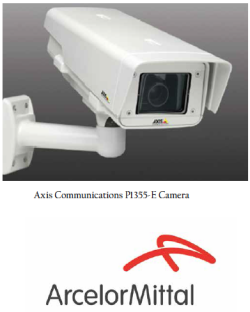 The software we will develop will use the high definition video from the camera to detect the edge of the mandrel (spindle) and the outer diameter of the coil of steel. The edge of the steel within the image will be detected using the Sobel method. The coil will reflect much more light and is thus brighter than the much darker surroundings. The program will take the image and, using the Sobel method, it will determine where rapid changes in the pixel color occur. By looking at these changes, it becomes apparent where the edges are because the image will have a large change in color between two pixels. The measurement of the coil will be a pixel distance, which can then be converted and calibrated to a physical diameter.
The software we will develop will use the high definition video from the camera to detect the edge of the mandrel (spindle) and the outer diameter of the coil of steel. The edge of the steel within the image will be detected using the Sobel method. The coil will reflect much more light and is thus brighter than the much darker surroundings. The program will take the image and, using the Sobel method, it will determine where rapid changes in the pixel color occur. By looking at these changes, it becomes apparent where the edges are because the image will have a large change in color between two pixels. The measurement of the coil will be a pixel distance, which can then be converted and calibrated to a physical diameter.
The computer will be able to communicate with the existing system over an Ethernet network. The software will be able to take inputs from the existing computer system and communicate with ArcelorMittal’s current Programmable Logic Controllers to provide a more accurate diameter to make appropriate coil sizes based on the needs of customers of ArcelorMittal.
MSU College of Engineering: A Point of Sale Grocery Cart
The goal of the point of sale grocery cart is to create an easier system for shoppers to use, while cutting down on the costs for the store. This new system involves placing the scanner normally wielded by the cashier into the hands of every shopper. As a patron of the store travels between aisles and gathers items, they can use their smartphone to scan the items as they put them into their cart.
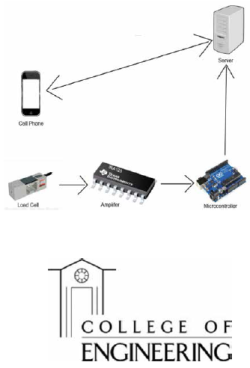 Once an item has been scanned, the cart, which is equipped with a set of load cells, reads the weight of the item added to the cart and verifies it with the store’s database. This helps confirm the correct item was placed in the cart. In some cases an image of the item will be taken to identify it. When finished shopping, the shopper will be able to use a credit card to checkout directly from their phone. This means they can skip the long checkout lines for good. The carts will be able to leave the store once the customer has checked out. If the customer leaves without paying, an alarm will sound.
Once an item has been scanned, the cart, which is equipped with a set of load cells, reads the weight of the item added to the cart and verifies it with the store’s database. This helps confirm the correct item was placed in the cart. In some cases an image of the item will be taken to identify it. When finished shopping, the shopper will be able to use a credit card to checkout directly from their phone. This means they can skip the long checkout lines for good. The carts will be able to leave the store once the customer has checked out. If the customer leaves without paying, an alarm will sound.
In addition to the changes to the way a shopper checks out, the system can also automatically apply electronic coupons to the cart to avoid the chance of the user forgetting them. Lastly, the final product can recommend items to the shopper based on purchasing history and offer incentives, such as coupons, for purchasing these items again.
The current checkout system is in desperate need of an update to save time and money for both sides of the grocery store.
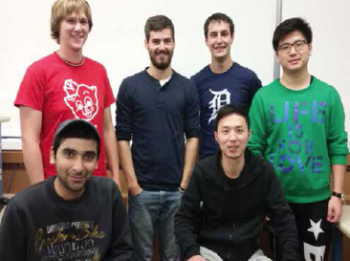
Team Members (Left to Right): Steven Hartz, Matt Rasmussen, Ben Lauzon, Shuangfei Liu, Husain Aleid, Taoping Zhao
MSU Electrical and Computer Engineering: Compact DC/AC Power Inverter
Power inverters are used to convert direct current, such as that from a battery, to alternating current, such as what can be drawn from a standard wall outlet. These devices are used in a large number of applications, including conditioning energy derived from solar cells into usable power and supplying electricity to household appliances during power outages. These devices are usually large; around the size of a cooler.
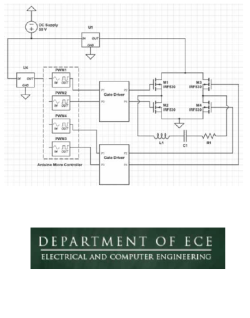 Team 7 will design and build their own power inverter inspired by the Little Box Challenge, a contest hosted by Google and IEEE. The idea of this challenge is to create an inverter both very small, 40 cubic inches, and also powerful enough to rival the output of its larger counterparts. Accomplishing this small form factor would be an important step in attaining widespread high power inverter utilization. This would also increase the feasibility of solar power generation for the masses in the future.
Team 7 will design and build their own power inverter inspired by the Little Box Challenge, a contest hosted by Google and IEEE. The idea of this challenge is to create an inverter both very small, 40 cubic inches, and also powerful enough to rival the output of its larger counterparts. Accomplishing this small form factor would be an important step in attaining widespread high power inverter utilization. This would also increase the feasibility of solar power generation for the masses in the future.
The goal is to achieve a 1 kilo-volt-amp power output. The process involves inputting direct current, stepping the voltage to the alternating current peak value, and using pulse width modulation from a microcontroller to drive transistors. This will create a 60 Hz sinusoid, which is the set frequency standard for wall outlets in the United States. Harmonic filtering is required before the output to comply with FCC regulations. Any inefficiency in the inverting process results in excess heat, so close attention will be paid to the efficiency of components and heat dissipation.

Team Members (Left to Right): Philip Beard, Jacob Brettrager, Jack Grundemann, Stanley Karas, Travis Meade
MSU Solar Car: Maximum Power Point Tracker
T he Michigan State Solar Car Racing Team tasked us with creating a new Maximum Power Point Solar tracker for their new solar car.
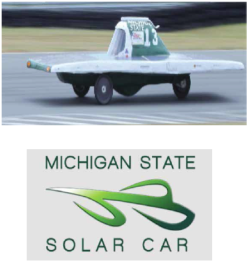 A maximum power point tracker is the device that connects the solar array of the solar car to the battery. This device is necessary because the solar array has a relatively low voltage. The MPPT device is used to match this low voltage to the high voltage of the battery.
A maximum power point tracker is the device that connects the solar array of the solar car to the battery. This device is necessary because the solar array has a relatively low voltage. The MPPT device is used to match this low voltage to the high voltage of the battery.
The MMPT device maximizes the power of the solar array by finding the point at which the voltage is highest without the current dropping.
Maximum Power Point Tracking is used in any device that contains a solar array. It is used in cars, buses, landscaping, chargers, pools, boats, etc.
Our team has one main requirement while creating the MPPT and that is to achieve 95% efficiency for our device. Once that goal is achieved, we will focus on making our design as small, light, and cost-effective as possible.

